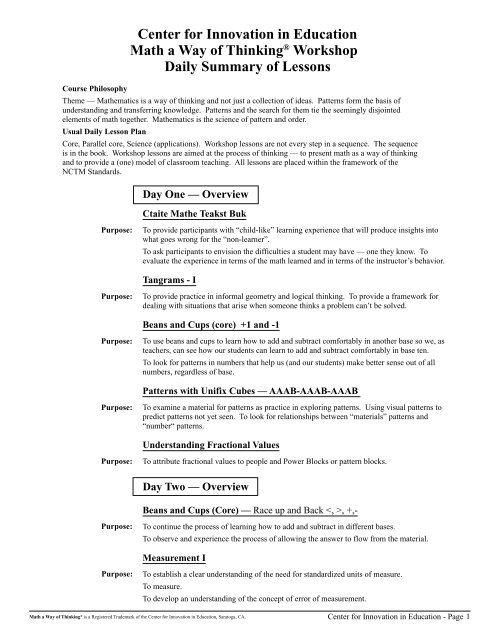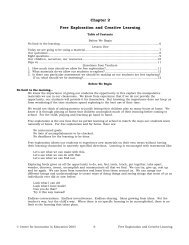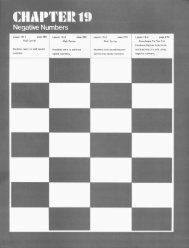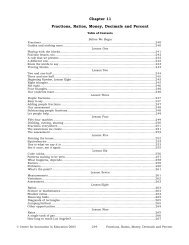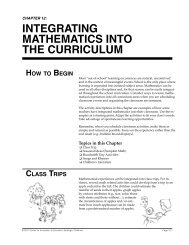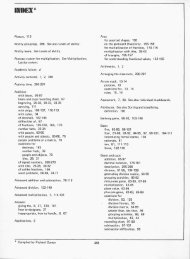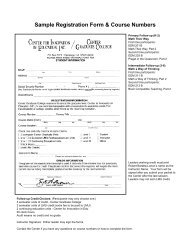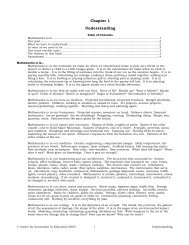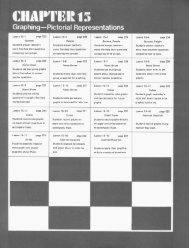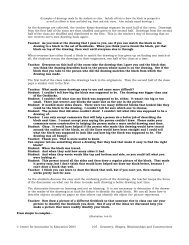Math a Way of Thinking Course Syllabus - Center for Innovation in ...
Math a Way of Thinking Course Syllabus - Center for Innovation in ...
Math a Way of Thinking Course Syllabus - Center for Innovation in ...
You also want an ePaper? Increase the reach of your titles
YUMPU automatically turns print PDFs into web optimized ePapers that Google loves.
<strong>Center</strong> <strong>for</strong> <strong>Innovation</strong> <strong>in</strong> Education<strong>Math</strong> a <strong>Way</strong> <strong>of</strong> <strong>Th<strong>in</strong>k<strong>in</strong>g</strong> ® WorkshopDaily Summary <strong>of</strong> Lessons<strong>Course</strong> PhilosophyTheme — <strong>Math</strong>ematics is a way <strong>of</strong> th<strong>in</strong>k<strong>in</strong>g and not just a collection <strong>of</strong> ideas. Patterns <strong>for</strong>m the basis <strong>of</strong>understand<strong>in</strong>g and transferr<strong>in</strong>g knowledge. Patterns and the search <strong>for</strong> them tie the seem<strong>in</strong>gly disjo<strong>in</strong>tedelements <strong>of</strong> math together. <strong>Math</strong>ematics is the science <strong>of</strong> pattern and order.Usual Daily Lesson PlanCore, Parallel core, Science (applications). Workshop lessons are not every step <strong>in</strong> a sequence. The sequenceis <strong>in</strong> the book. Workshop lessons are aimed at the process <strong>of</strong> th<strong>in</strong>k<strong>in</strong>g — to present math as a way <strong>of</strong> th<strong>in</strong>k<strong>in</strong>gand to provide a (one) model <strong>of</strong> classroom teach<strong>in</strong>g. All lessons are placed with<strong>in</strong> the framework <strong>of</strong> theNCTM Standards.Day One — OverviewCtaite <strong>Math</strong>e Teakst BukPurpose:To provide participants with “child-like” learn<strong>in</strong>g experience that will produce <strong>in</strong>sights <strong>in</strong>towhat goes wrong <strong>for</strong> the “non-learner”.To ask participants to envision the difficulties a student may have — one they know. Toevaluate the experience <strong>in</strong> terms <strong>of</strong> the math learned and <strong>in</strong> terms <strong>of</strong> the <strong>in</strong>structor’s behavior.Tangrams - IPurpose:To provide practice <strong>in</strong> <strong>in</strong><strong>for</strong>mal geometry and logical th<strong>in</strong>k<strong>in</strong>g. To provide a framework <strong>for</strong>deal<strong>in</strong>g with situations that arise when someone th<strong>in</strong>ks a problem can’t be solved.Beans and Cups (core) +1 and -1Purpose:To use beans and cups to learn how to add and subtract com<strong>for</strong>tably <strong>in</strong> another base so we, asteachers, can see how our students can learn to add and subtract com<strong>for</strong>tably <strong>in</strong> base ten.To look <strong>for</strong> patterns <strong>in</strong> numbers that help us (and our students) make better sense out <strong>of</strong> allnumbers, regardless <strong>of</strong> base.Patterns with Unifix Cubes — AAAB-AAAB-AAABPurpose:To exam<strong>in</strong>e a material <strong>for</strong> patterns as practice <strong>in</strong> explor<strong>in</strong>g patterns. Us<strong>in</strong>g visual patterns topredict patterns not yet seen. To look <strong>for</strong> relationships between “materials” patterns and“number“ patterns.Understand<strong>in</strong>g Fractional ValuesPurpose:To attribute fractional values to people and Power Blocks or pattern blocks.Day Two — OverviewBeans and Cups (Core) — Race up and Back , +,-Purpose:To cont<strong>in</strong>ue the process <strong>of</strong> learn<strong>in</strong>g how to add and subtract <strong>in</strong> different bases.To observe and experience the process <strong>of</strong> allow<strong>in</strong>g the answer to flow from the material.Measurement IPurpose:To establish a clear understand<strong>in</strong>g <strong>of</strong> the need <strong>for</strong> standardized units <strong>of</strong> measure.To measure.To develop an understand<strong>in</strong>g <strong>of</strong> the concept <strong>of</strong> error <strong>of</strong> measurement.<strong>Math</strong> a <strong>Way</strong> <strong>of</strong> <strong>Th<strong>in</strong>k<strong>in</strong>g</strong> ® is a Registered Trademark <strong>of</strong> the <strong>Center</strong> <strong>for</strong> <strong>Innovation</strong> <strong>in</strong> Education, Saratoga, CA.<strong>Center</strong> <strong>for</strong> <strong>Innovation</strong> <strong>in</strong> Education - Page 1
Measurement IIPurpose:To learn considerations important <strong>in</strong> communication, measurement, and giv<strong>in</strong>g directions.To measure.To practice draw<strong>in</strong>g and read<strong>in</strong>g maps.Geoboard — AreaPurpose:To provide necessary skill to f<strong>in</strong>d the surface area <strong>of</strong> geometric shapes. On a later day, thisskill is used <strong>in</strong> pattern searches which lead to predict<strong>in</strong>g areas <strong>in</strong> advance <strong>of</strong> work<strong>in</strong>g them out.Sort and Classify<strong>in</strong>gPurpose:To provide background <strong>in</strong><strong>for</strong>mation on the downfall <strong>of</strong> “sets” as it relates to the elementaryschool curriculum, and the rema<strong>in</strong><strong>in</strong>g value <strong>of</strong> “sort<strong>in</strong>g and classify<strong>in</strong>g”.To show that it is the foundation <strong>of</strong> much <strong>of</strong> science, particularly the natural sciences.To demonstrate the key to the process is logical th<strong>in</strong>k<strong>in</strong>g.Surround<strong>in</strong>g PatternsPurpose:To exam<strong>in</strong>e a material <strong>for</strong> patterns as practice <strong>in</strong> explor<strong>in</strong>g patterns. Us<strong>in</strong>g visual patterns topredict patterns not yet seen. To look <strong>for</strong> relationships between “materials” patterns and“number“ patterns.Tangrams IIPurpose:To provide practice <strong>in</strong> <strong>in</strong><strong>for</strong>mal geometry and logical th<strong>in</strong>k<strong>in</strong>g. To provide a framework <strong>for</strong>deal<strong>in</strong>g with situations that arise when someone th<strong>in</strong>ks a problem can’t be solved.Day Three OverviewBeans and Cups — MultiplicationPurpose:To provide participants with an understand<strong>in</strong>g <strong>of</strong> the process <strong>of</strong> multiplication through assembl<strong>in</strong>gmultiplication matrices <strong>in</strong> a variety <strong>of</strong> bases.To explore the matrices <strong>for</strong> possible patterns.To build an understand<strong>in</strong>g <strong>of</strong> two place multiplication.Structures I — 3-D ConstructionPurpose:To learn some geometric and eng<strong>in</strong>eer<strong>in</strong>g concepts concretely that have traditionally beenpresented abstractly.To provide participants with the background necessary to be successful <strong>in</strong> Structures II.To provide experience at kite build<strong>in</strong>g.Geoboard FormulasPurpose:To use knowledge <strong>of</strong> comput<strong>in</strong>g areas ga<strong>in</strong>ed <strong>in</strong> an earlier lesson to generate data to exam<strong>in</strong>e<strong>for</strong> patterns.To learn where a good deal <strong>of</strong> what we were taught as “given” <strong>for</strong>mulas came from <strong>in</strong> the firstplace.ProbabilityPurpose:To learn a skill useful <strong>in</strong> draw<strong>in</strong>g <strong>in</strong>creased mean<strong>in</strong>g from graphs.To ga<strong>in</strong> a better understand<strong>in</strong>g <strong>of</strong> the nature <strong>of</strong> “chance”<strong>Center</strong> <strong>for</strong> <strong>Innovation</strong> <strong>in</strong> Education - Page 2
Sort and Classify<strong>in</strong>g — People sort<strong>in</strong>g — DescriptionsPurpose:To practice sort<strong>in</strong>g skills learned <strong>in</strong> previous lesson.Pal<strong>in</strong>dromesPurpose:To demonstrate addition practice motivated by the search <strong>for</strong> patterns.Coord<strong>in</strong>ate Graph<strong>in</strong>g — Coord<strong>in</strong>ate GeometryPurpose:To learn a new <strong>for</strong>m <strong>of</strong> graph<strong>in</strong>g <strong>for</strong> organiz<strong>in</strong>g specific k<strong>in</strong>ds <strong>of</strong> data <strong>in</strong>to displays more useful<strong>for</strong> mak<strong>in</strong>g predictions.To learn a little about what algebra is all about.Day Four OverviewBeans and Cups — DivisionPurpose:To provide participants with an understand<strong>in</strong>g <strong>of</strong> the process <strong>of</strong> division by creat<strong>in</strong>g andsolv<strong>in</strong>g division problems <strong>in</strong> other bases.To exam<strong>in</strong>e the relationships between multiplication and division, which accounts <strong>for</strong> why the“answer is on the top and why division might be recorded the way it is”.Tiles + , - , x, ÷Purpose:To use pattern searches as motivation <strong>for</strong> work<strong>in</strong>g simple addition, subtraction and multiplicationTo provide a look at some number patterns that will occur aga<strong>in</strong> and aga<strong>in</strong>.Pool Hall <strong>Math</strong>Purpose:To explore a simple activity <strong>for</strong> the variety <strong>of</strong> patterns that emerge.To demonstrate that patterns are everywhere and that many patterns reoccur <strong>in</strong> seem<strong>in</strong>glyunrelated situationsGraph<strong>in</strong>g — Pictorial RepresentationsPurpose:To graph data so that relationships may be observed visually.To learn how to ask questions about graphs.Structures IIPurpose:To use the pr<strong>in</strong>ciples learned <strong>in</strong> the previous Structures lesson to build stable structures.Pendulums — SciencePurpose:To apply a wide variety <strong>of</strong> problem-solv<strong>in</strong>g techniques and mathematical knowledge to ascience activity.To study a little physicsDay Five — OverviewChip Trad<strong>in</strong>g + , - , x , ÷Purpose:To learn how to use “chips” <strong>for</strong> addition, subtraction, multiplication and division.To see why chips come after beans and cups and not be<strong>for</strong>e.<strong>Center</strong> <strong>for</strong> <strong>Innovation</strong> <strong>in</strong> Education - Page 3
Shell Game — SciencePurpose:To apply problem-solv<strong>in</strong>g techniques and mathematical knowledge to a science activity.To set up experiments to f<strong>in</strong>d answers.To practice liv<strong>in</strong>g with not know<strong>in</strong>g all the answers.To know what it feels like to a “scientist”.Cube Stick FractionsPurpose:To exam<strong>in</strong>e fractions generated with cube sticks <strong>for</strong> patternsGeoboard — Multiplication <strong>of</strong> fractionsPurpose:To exam<strong>in</strong>e numbers <strong>for</strong> patterns that lead to develop<strong>in</strong>g a rule <strong>for</strong> the multiplication <strong>of</strong>fractions.1 - 2 - 4 - 8 - 16 - 32Purpose:To look <strong>for</strong> patterns.To see the power <strong>of</strong> materials to show th<strong>in</strong>k<strong>in</strong>g, and their power to show what numbersrepresent.Build<strong>in</strong>g Beh<strong>in</strong>d a ShieldPurpose:To demonstrate three models <strong>for</strong> teach<strong>in</strong>g.SUMMARYThe <strong>Center</strong> <strong>for</strong> <strong>Innovation</strong> <strong>in</strong> Education is a nonpr<strong>of</strong>it educational organization which provides support to teacherswho use the <strong>Math</strong> a <strong>Way</strong> <strong>of</strong> <strong>Th<strong>in</strong>k<strong>in</strong>g</strong> philosophy <strong>of</strong> teach<strong>in</strong>g. This support takes the follow<strong>in</strong>g <strong>for</strong>ms:1. Hold<strong>in</strong>g 30 hour workshops on the teach<strong>in</strong>g <strong>of</strong> <strong>Math</strong> a <strong>Way</strong> <strong>of</strong> <strong>Th<strong>in</strong>k<strong>in</strong>g</strong> across the U.S. and Canada throughoutthe year.2. Hold<strong>in</strong>g follow-up classes <strong>for</strong> participants dur<strong>in</strong>g the school year to assist teachers withimplementation <strong>of</strong> the program.3. Provid<strong>in</strong>g math kits and materials at reasonable prices to teachers.For additional <strong>in</strong><strong>for</strong>mation, please contact us.<strong>Center</strong> <strong>for</strong> <strong>Innovation</strong> <strong>in</strong> EducationP.O. Box 2070Saratoga, CA 95070-0070http://www.center.edu800-395-6088 • fax: 408-725-8146<strong>Center</strong> <strong>for</strong> <strong>Innovation</strong> <strong>in</strong> Education - Page 4


